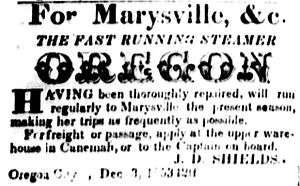Oregon (sidewheeler 1852)
 Advertisement for Oregon, placed March 10, 1854 | |
| History | |
|---|---|
| Name: | Oregon |
| Owner: | Ben Simpson and others |
| Route: | Upper Willamette River |
| In service: | 1852 |
| Out of service: | 1854 |
| Fate: | Sunk after striking snag, total loss |
| General characteristics | |
| Type: | inland steamship |
| Length: | 120 ft (36.6 m) exclusive of fantail |
| Beam: | 22 ft (6.7 m) exclusive of guards |
| Depth: | 5 ft (2 m) depth of hold |
| Installed power: | steam engine |
| Propulsion: | side-wheel |
Oregon was a side-wheel driven steamboat that operated on the Willamette River in the state of Oregon from 1852 to 1854. The steamer was not economically successful and became a total loss by sinking after a short career.
Construction
Oregon was built at Fairfield, Oregon in the summer of 1852.[1] Fairfield was located sixteen miles downstream from Salem, Oregon, and it was once one of the most important wheat shipping points on the Willamette River.[2] Ben Simpson, the held of the original ownership syndicate, was also the builder.[1] Construction was supervised in the summer of 1852 by George A. Pease (1830-1918).[1]
Oregon was 120 feet long.[3] The beam (width) of the steamer was 22 feet, probably exclusive of the guards.[3] The depth of hold was 5 feet.[3]
Oregon was described as a small sidewheeler and a poor money earner.[4]
Operations
.jpg)
Upon completion, Parker and J.D. Shields served as captains.[1] George A. Pease was the pilot of the Oregon until July 1853.[1] Starting on December 3, 1853, the "fast running steamer" Oregon was advertised as making regular runs from Oregon to Marysville, as Corvallis was then known, and way landings.[5]
On March 4, 1854, the steamer Oregon was reported to have been purchased by the Williamette Falls Mill and Transport Company, sometimes referred to as the Willamette Falls Company.[6]
On March 17, 1854, the Willamette Falls Company placed into service a new steamer, the side-wheeler Gazelle, giving the company, briefly, two steamers operating above Willamette Falls.[3][7]
Loss
Shortly after Gazelle was placed in operation, Oregon was sunk and became a total loss. Oregon hit a snag just down river from Salem, and began sinking.[8] Word was passed to Gazelle, which steamed upriver and stood by as Oregon was filling with water.[8]
Cargo from the Oregon was loaded onto Gazelle to lighten Oregon to better allow salvaging.[8] Suddenly Oregon broke free of the snag, drifted downstream, ran up on a sandbar and sank so deeply that only a part of the upper works were visible above the water.[8] Oregon was a total loss.[8]
Gazelle itself was destroyed by a boiler explosion only a short time later, on April 8, 1854, ending the brief steamboat operations of the Willamette Falls Company[7]
Notes
- 1 2 3 4 5 Wright, E.W., ed. (1895). "Chapter 2: Development of Local Marine Traffic, Building of Sailing and Steam Vessels". Lewis & Dryden's Marine History of the Pacific Northwest. Portland, OR: Lewis and Dryden Printing Co. 27. LCCN 28001147.
- ↑ Corning, Howard McKinley (1973). "Wheat Ports of the Middle River … Fairfield Landing". Willamette Landings -- Ghost Towns of the River (2nd ed.). Portland, OR: Oregon Historical Society. pgs. 89-94. ISBN 0875950426.
- 1 2 3 4 Affleck, Edward L. (2000). "Part One: Chapter Two: Columbia River Waterways — List of Vessels". A Century of Paddlewheelers in the Pacific Northwest, the Yukon, and Alaska. Vancouver, BC: Alexander Nicholls Press. pgs. 14 and 22. ISBN 0-920034-08-X.
- ↑ Wright, E.W., ed. (1895). "Chapter 3: Steam Navigation on Upper Willamette, Rapid Growth of River Business". Lewis & Dryden's Marine History of the Pacific Northwest. Portland, OR: Lewis and Dryden Printing Co. 37. LCCN 28001147.
- ↑ "For Marysville, &c.", Oregon Spectator (advertisement), Oregon City, O.T.: C.L. Goodrich, 7 (4), p.4, col.1., Mar 10, 1854
- ↑ "The steamer "Oregon" has been purchased by …", Oregon Spectator, Oregon City, O.T.: C.L. Goodrich, 7 (3), p.2, col.1, Mar 4, 1854
- 1 2 Corning, Howard McKinley (1973). "Lost Towns of Willamette Falls … Canemah, "the Canoe Place"". Willamette Landings -- Ghost Towns of the River (2nd ed.). Portland, OR: Oregon Historical Society. p.64. ISBN 0875950426.
- 1 2 3 4 5 Mills, Randall V. (1947). "Chapter 9: As the Sparks Fly Upwards". Sternwheelers up Columbia -- A Century of Steamboating in the Oregon Country. Lincoln NE: University of Nebraska. 115. ISBN 0-8032-5874-7. LCCN 77007161.
References
Printed sources
- Affleck, Edward L. (2000). A Century of Paddlewheelers in the Pacific Northwest, the Yukon, and Alaska. Vancouver, BC: Alexander Nicholls Press. ISBN 0-920034-08-X.
- Corning, Howard McKinley (1973). Willamette Landings -- Ghost Towns of the River (2nd ed.). Portland, OR: Oregon Historical Society. ISBN 0875950426.
- Mills, Randall V. (1947). Sternwheelers up Columbia -- A Century of Steamboating in the Oregon Country. Lincoln NE: University of Nebraska. ISBN 0-8032-5874-7. LCCN 77007161.
- Timmen, Fritz (1973). Blow for the Landing -- A Hundred Years of Steam Navigation on the Waters of the West. Caldwell, ID: Caxton Printers. ISBN 0-87004-221-1. LCCN 73150815.
- Wright, E.W., ed. (1895). Lewis & Dryden's Marine History of the Pacific Northwest. Portland, OR: Lewis and Dryden Printing Co. LCCN 28001147.
